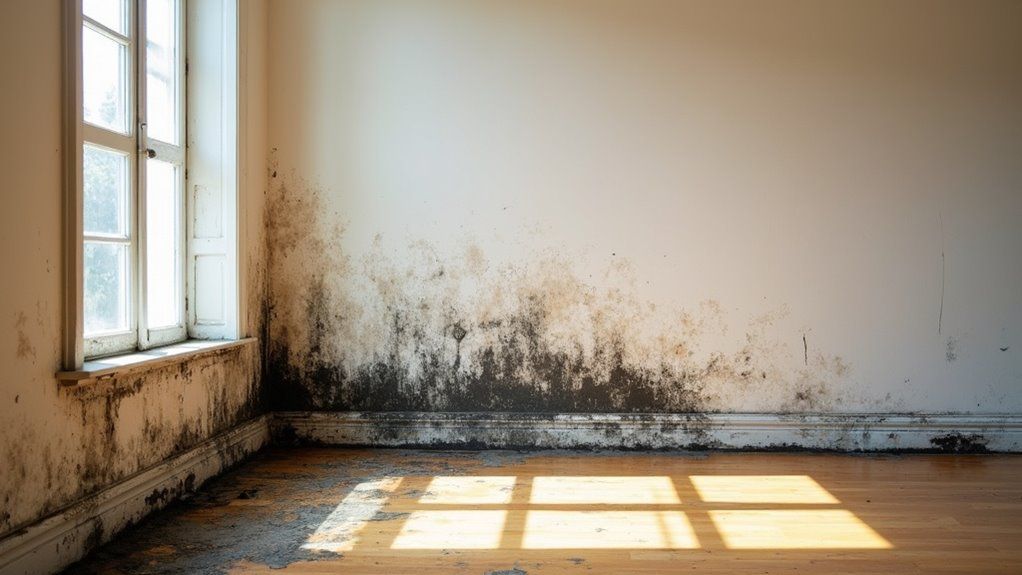How Mold and Water Damage Affect Home Value

Mold and water damage can quietly destroy a home's value. Many homeowners do not realize how much these issues matter. Buyers often hesitate when they see any sign of these problems.
These concerns can lead to lower offers, longer sales, or even canceled deals. Moisture and mold also create health risks, which scare off careful buyers. Appraisers may reduce the home's value, making it harder to secure loans.
Mold and water damage can significantly lower your home's market value and buyer appeal. The best solution is to address these problems quickly and thoroughly before listing your property. This helps protect your investment and builds buyer trust.
This blog will guide you through recognizing, fixing, and preventing mold and water damage to help you sell with confidence.
Key Takeaways
- Mold and water damage can lower home value by 20% to 50%, especially if issues remain unresolved or undisclosed.
- Visible mold, musty odors, and water stains deter buyers and prolong sale times by reducing market appeal.
- Structural damage from water weakens foundations and support systems, leading to costly repairs and lower appraisals.
- Disclosure of past or present mold and water issues can decrease a home’s selling price unless fully resolved and documented.
- Professional remediation and proof of repairs restore buyer confidence and help maintain or recover property value.
Understanding the Basics of Mold and Water Damage
Mold and water damage can harm your property and lower its value. Mold grows quickly in wet spaces and can cause health problems. Water damage can also weaken walls, floors, and foundations.
Addressing these issues promptly can prevent further deterioration and costly repairs. If you notice dampness or musty smells, you should act quickly. Early action can stop more damage and lower repair costs. Delays often lead to bigger problems. Professional help is important for mold removal and water restoration.
Experts use special tools and methods to fix the problem completely. If you hire professionals, you can protect your home and keep it safe. Additionally, understanding the effects on home value of mold and water damage can help prioritize repairs.
If you want to sell your property, addressing these issues helps keep its value. A healthy home is more appealing to buyers. Taking care of mold and water damage early is a smart move for any homeowner, especially considering how tenant occupancy can influence property sales and repairs.
Common Causes of Mold Growth in Homes
Mold grows in homes when there is too much moisture. Common causes include leaks, high humidity, and poor ventilation. If you control moisture, you can often prevent mold.
Leaky roofs or windows can let in water and cause mold. Plumbing leaks behind walls or under floors also create a perfect spot for mold. Flooding that is not dried out quickly will almost always lead to mold. Additionally, home inspections can help identify early signs of water intrusion before mold develops.
Bathrooms, kitchens, and basements without good airflow are at higher risk. If rooms stay humid or damp, mold may appear. Regular checks and quick repairs help keep your home mold-free.
If you address these issues early, you will protect your home’s value. Proactive maintenance keeps your property safe and healthy. Swift action saves money and avoids bigger problems later. Recognizing potential in challenging properties can help you take timely steps to prevent extensive damage.
Signs of Water Damage Every Homeowner Should Know
You need to watch for warning signs like discoloration, persistent musty odors, and peeling paint or wallpaper, as these can signal hidden water damage. Spotting these issues early helps you protect your property value and avoid costly repairs. By addressing them promptly, you'll strengthen your home's appeal in a competitive market.
Additionally, understanding water damage impacts can help you make informed decisions about repairs and maintenance. Recognizing the importance of quick sale options can also be beneficial if your property has sustained significant damage that affects its marketability.
Discoloration and Staining
Discoloration and staining are key signs of water damage. These marks can help you spot problems before they get worse. If you notice them, you should check for water leaks right away.
Discoloration often looks like patches or streaks on walls or ceilings. Stains may be brown, yellow, or gray in color. Some marks appear near windows, doors, or along baseboards.
Paint might peel or bubble around stained areas. Stains that grow or darken over time can mean the problem is ongoing. Early detection may help you avoid costly repairs.
Musty Odors Persist
Musty odors that do not go away often mean there is hidden water damage in your home. This can lower your property value. Buyers may think the smell comes from mold or moisture.
Air fresheners will not fix the real issue. People can tell when you try to cover up odors. If you want to sell your home, you should find where the smell comes from.
Check places like basements, crawl spaces, and behind walls for leaks or wet spots. Fixing the source of the problem is important. This shows buyers you take care of your home and helps keep its value.
Peeling Paint or Wallpaper
Peeling paint or wallpaper is a clear sign of water damage in your home. Moisture behind walls makes paint bubble, crack, or peel. Wallpaper can warp, bubble, or come loose from the wall.
This kind of damage lowers your home’s value and attracts negative attention from buyers. If you see these issues, there could be deeper problems with leaks or humidity. Buyers may use visible water damage to ask for a lower price.
If you repair peeling paint and wallpaper quickly, you can help protect your home’s value. Professional evaluation is helpful if you notice these signs. Addressing water damage early can save you money and stress.
The Impact of Mold on Indoor Air Quality
Mold can lower indoor air quality by releasing spores and fragments into the air. These particles often cause allergies and breathing problems for people in the home. Mold usually grows in damp and poorly ventilated areas. If a house has mold, it may smell musty or show visible spots.
Potential buyers might avoid such homes, which can lower the property’s value. Mold problems usually lead to lower offers and longer selling times. Addressing fire damage costs and ongoing maintenance can significantly improve the home's market appeal. Professional mold removal can solve these air quality issues.
Properly managing property condition disclosures ensures transparency and builds trust with buyers. If you fix the problem, buyers will see that the home is well cared for. A clean, mold-free home is healthier and more appealing to future owners.
Health Risks Associated With Mold Exposure
Mold exposure can cause health problems for people living in your home. Mold releases spores into the air, which can trigger several symptoms. If not addressed, mold may also lower your home's value and make it harder to sell. Ensuring proper property disclosures about mold issues is important for transparency during sales.
People may develop a cough, sneeze often, or have trouble breathing when exposed to mold. Those with asthma or allergies could see their symptoms get worse. If someone is already sick or has a weak immune system, mold can increase their risk of lung infections.
Environmental factors like humidity and poor ventilation can contribute to mold growth and exacerbate health risks. Headaches and tiredness are also possible if mold is present indoors. Some people might find it harder to focus or think clearly. Mold spores can also cause skin rashes or make eyes red and itchy.
How Water Damage Compromises Structural Integrity
Water damage weakens a home's structure and lowers its value. Moisture can damage wood, drywall, and concrete. If this happens, the foundation and main support systems may become unsafe. Ensuring a clear title before repairs can help facilitate smooth transactions and protect your investment. Wood rot in framing leads to less trust from buyers. Cracked foundation walls cause the property value to drop.
Sagging floors or ceilings may force sellers to negotiate for repairs. If you act quickly, you can avoid these problems. Regular inspections and good drainage help prevent water damage. Proper repairs protect your home and keep its value strong. Additionally, implementing proper water mitigation measures can significantly reduce the risk of future damage.
Mold and Water Damage: Effect on Property Appraisal
When an appraiser spots mold or water damage, they’ll flag these issues as risks that can significantly reduce your property’s value. You should expect value reduction estimates to reflect repair costs and buyer hesitation. Proactive disclosure helps you control the narrative and adjust pricing strategically in a competitive market.
Additionally, addressing issues promptly can facilitate a faster sale, especially if you're considering a quick transaction through a fast home sale services in Claremore OK. Understanding market conditions and how repairs impact valuation can better position you during negotiations and help you avoid financial losses.
Appraisal Red Flags Identified
Property appraisers notice signs of mold and water damage right away. These issues lower your home's value because they show possible hidden problems. If you want to protect your home's value, you should know what appraisers look for and fix problems early.
Appraisers look for visible mold, strong musty smells, and water stains on ceilings, walls, or floors. If there is evidence of flooding, leaks, or moisture around windows and basements, they will make note of it. Missing documents for past repairs or insurance claims can also raise concerns.
If homeowners address these problems quickly, they can avoid a lower appraisal. Early repairs show care and help maintain the home's value. Proper documentation of repairs is also important for a positive appraisal.
Value Reduction Estimates
Homes with mold or water damage can lose 20% to 50% of their value. The exact loss depends on how bad the problem is and where the home is located. Appraisers pay close attention to unresolved mold or water issues.
Professional mold cleanup or water repairs can help lower this loss. Some drop in value may remain even after fixing the problem. Buyers may still worry about future risks.
If you fix these issues early, you can protect your home’s value. Keep records of all repairs to show appraisers and buyers. A well-restored home can attract more interest and higher offers.
Disclosure Impact on Pricing
Disclosure can lower your home's price if mold or water damage is present. Buyers and appraisers use this information to judge value. If you are open about problems, buyers may trust you more but offer less.
Appraisers consider the damage and estimate repair costs. If repairs are expensive, they may lower your home's appraisal. Buyers might ask for records of any mold removal.
If you have fixed the issues, buyers could still want a discount. Waterproofing costs may also affect the final price. If you hide problems and they are found later, legal trouble or canceled deals may result.
Being honest can make selling faster but might reduce your profit. Hidden damage almost always causes bigger problems later. Always weigh the risks before deciding what to disclose.
Buyer Perceptions of Mold and Water Issues
Most buyers see mold and water damage as a sign of bigger problems. They often worry about high repair costs and health risks. This can make your home less attractive in the market. Additionally, providing transparent documentation of repairs can significantly boost buyer confidence and help your home stand out.
If you have fixed these issues, always provide clear records of the work. Buyers want proof that the problems are fully resolved. Proper documentation helps build trust and confidence.
When you address these concerns openly, you show buyers there is nothing to hide. Highlighting repairs and professional work can improve your home's appeal. This approach can help you get better offers.
Home Inspection Reports and Disclosure Requirements
Home inspection reports and disclosure requirements can lower your home’s value after mold or water damage. If inspectors find mold or leaks, buyers may worry. Buyers will want proof that you fixed these problems.
Inspection reports list any water damage or mold that was found. Buyers may offer less money if repairs are not clearly shown. They may also ask for more repairs before agreeing to buy.
Water leak detection reports can help buyers feel more confident. If you provide clear evidence of repairs, it can help your sale. Full disclosure is often required by law and builds trust.
If you hide problems, you could face legal trouble later. Honest documentation prevents disputes after the sale. Being open can also help your home sell faster.
Cost of Remediation and Repairs
You'll need to weigh the high cost of professional restoration against the risks and limitations of DIY repairs when addressing mold and water damage. Don't overlook potential insurance coverage gaps, which can leave you responsible for significant out-of-pocket expenses. Understanding these factors helps you make informed, powerful decisions that protect your property's value.
Professional Restoration Expenses
Professional restoration expenses are costs you pay to fix mold and water damage in your home. These services help maintain your home’s value and appeal. If you ignore the damage, your property may lose value or attract fewer buyers.
Certified technicians follow safety and building rules during repairs. Professional mold removal addresses both visible and hidden mold growth. If you use experts, they can also prevent further water damage.
Restoration teams use special equipment for drying and cleaning. Good documentation of repairs can help with future sales or insurance claims. If you invest in professional help, your property is more likely to stay valuable.
DIY Repair Limitations
DIY repairs for mold and water damage rarely fix the whole problem. Mold grows in hidden spots, and water can weaken structures. Simple cleaning or painting does not solve these issues.
Homeowners often miss moisture trapped in walls or floors. Missed damage leads to mold returning or spreading. If you do not remove all wet materials, problems will come back.
DIY fixes can lower your home's value. Inspectors and buyers notice poor repairs during a sale. If you want to protect your property, consider the true repair needs before starting a DIY project.
Insurance Coverage Gaps
Homeowners insurance often does not cover all types of mold and water damage. Many policies have exclusions and limits that can leave you paying large repair bills. It is important to know what your insurance does and does not cover.
Some policies do not pay for damage from slow leaks or long-term moisture. Mold cleanup is often capped at a low amount, sometimes just a few thousand dollars. If you do not report damage quickly, your claim could be denied.
Insurance may also limit coverage for repairs to walls, floors, or other structures. Optional add-ons, called endorsements or riders, can help fill some of these gaps. If you want better protection, you should review your policy and consider extra coverage.
Insurance Considerations for Mold and Water Damage
Insurance can help cover the costs of mold and water damage, but there are important limits. Policies often cover sudden problems, like burst pipes. Most do not cover slow leaks or mold from neglect.
If your insurance does not cover mold or water damage, you may pay a lot yourself. Unfixed damage can lower your home's value and scare off buyers. Buyers may also worry about future problems.
You should read your policy carefully to know what is covered. Ask your insurance agent if you have questions about your coverage. Understanding your policy helps you avoid surprises if damage happens.
Preventative Measures to Protect Home Value
Preventative measures help protect your home’s value by stopping mold and water damage before it starts. Taking action now makes your home safer and more attractive to buyers. Simple steps can also help keep your neighborhood safe.
Proper yard grading directs water away from your home’s foundation. Good gutters and downspouts move rainwater safely away. If you use landscaping to reduce standing water, you lower the risk of moisture problems.
Regular checks of your roof, windows, and plumbing can catch leaks early. Homeowners should fix small problems before they become costly. If neighbors work together, they can solve drainage or flooding issues that affect everyone.
These practical steps help protect your investment. They also increase buyer confidence if you decide to sell.
Best Practices for Addressing Mold and Water Issues Before Listing
Before listing your home, you’ll want to catch mold and water problems early through thorough inspections. Rely on certified professionals to remediate any issues, ensuring buyers see a move-in ready property. By also taking steps to prevent future occurrences, you protect your home’s value and market appeal.
Early Detection and Assessment
Early detection and assessment help increase your home's value and prevent costly problems before selling. If you check for mold and water damage early, you can fix issues before buyers find them. This makes your home more attractive in the market.
Homeowners should learn about signs of mold and water leaks. If you notice musty smells or stains on walls, investigate further. An early response can save money and time.
Visual checks of basements, attics, and crawl spaces are important. Moisture meters and infrared cameras can spot hidden dampness. Maintenance records may reveal past leaks or repairs that need attention.
Professional Remediation Strategies
Professional action is important if you find mold or water damage in your home. Certified experts can remove mold properly and safely. This protects your home’s value and makes it more appealing to buyers.
Water damage also needs quick attention from professionals. If specialists remove water quickly, they can prevent more mold and stop further damage. They use special equipment to dry out all affected areas.
Hiring experts shows you care for your property. If buyers see you take care of problems, they feel more confident. This can help you get a better price for your home.
Preventing Future Recurrence
Preventing future mold and water problems protects your home's value and attracts buyers. If you address risks early, you avoid expensive repairs later. Buyers will feel confident if your home is well maintained.
You should check your roof, pipes, and windows for leaks often. If you find leaks, fix them right away. Proper drainage keeps water away from your foundation.
Dehumidifiers help lower moisture in basements and other damp areas. Cracks in walls or floors should be sealed to stop water from getting in. Good airflow in bathrooms, kitchens, and laundry rooms helps control moisture.
If you follow these steps, your home will be move-in ready. Inspectors may find fewer problems if you take these actions. This can help your home sell faster and for a better price.
How to Market a Home With a History of Water or Mold Damage
To market a home with a history of water or mold damage, be honest with buyers about past issues. Share details about repairs and steps taken to fix the problem. Highlight the work done to prevent future damage.
If you show proof of professional remediation, buyers may feel more confident. Provide all repair records, warranties, and inspection reports. These documents can help answer buyer questions and build trust.
Stage the home to showcase its best features. Clean spaces, fresh paint, and good lighting can help buyers focus on the home’s value. If you price the home right, it may attract more interest.
Work with a real estate agent who has experience selling homes with similar histories. The agent can address buyer concerns and suggest the best marketing strategy. If you follow these steps, your chances of selling will improve.
Conclusion
If homeowners ignore mold and water damage, their property value can decrease significantly. Addressing these problems early can prevent bigger issues during a sale. If you want to sell your house quickly, fixing these issues is important.
When sellers invest in repairs and disclose any past problems, buyers feel more confident. This can make your home more appealing and help you get better offers. However, if repairs seem overwhelming, selling as-is may be a good option.
If you want a fast and easy sale, we buy houses for cash in any condition. Tulsa Home Buyers can help you avoid the stress of repairs and showings. Contact us today to get a fair cash offer on your home.
This is paragraph text. Click it or hit the Manage Text button to change the font, color, size, format, and more. To set up site-wide paragrapTulsa Home Buyers • August 24, 2025h and title styles, go to Site Theme.
Ready to work with Tulsa Home Buyers?
Let's connect! We’re here to help.
Send us a message and we’ll be in touch.
Or give us a call today at 111-222-3333


